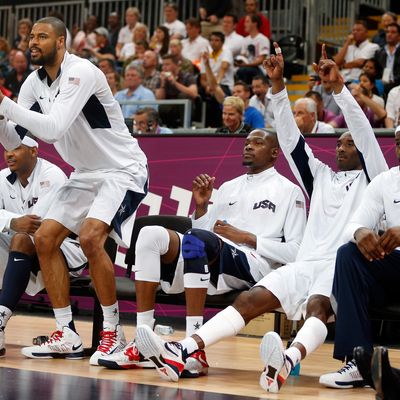
It was clear from the opening tip — won by France, the ball corralled by Tony Parker, who, for the first time, sported goggles to protect his vulnerable eye — France would be no match for the United States. The level of dominance displayed by the U.S. team will continue through most of group play, (Argentina presents the toughest challenge within Group A) and while the U.S. squad only led by one point after the first quarter, the final score — 98 to 71 — was indicative of how much better the Yanks were in their first contest of the XXX Olympics.
While it is worth noting the French were without Joakim Noah, who injured an ankle prior to the games, and Parker was clearly uncomfortable with his mandatory eyewear, the U.S. would have still overmatched France even if both players were healthy. The U.S.’s roster is so deep that coach Mike Krzyzewski could afford to play Anthony Davis for essentially the entire fourth quarter.
In a game that was not close after halftime, it is hard to take away much, but the U.S.’s defensive intensity was impossible to ignore. As we mentioned in our men’s basketball preview, the U.S. was committed to constant ball pressure during the pre-Olympic exhibition slate, and the team will continue to force turnovers in the quest for gold. Against France, the U.S. caused eighteen turnovers and swiped ten steals; while Parker was able to handle the pressure, the rest of the French had trouble getting clean looks at the basket. Hands were constantly thrust in the faces of the French shooters, and even when wings Nicolas Batum and Mickaël Gelabale had an open shot, a U.S. defender would quickly close out. There is a collective 22 all-NBA defensive team selections on the U.S.’s roster, and though France did shoot well over 50 percent from within the arc, their perimeter shooting was hampered by the U.S.’s pressure (9.1 percent from three-point range).
Just as he performed during the exhibition slate, Kevin Durant was the most talented offensive player on the court yesterday. The Thunder star scored 22 points and showed why he is toughest offensive matchup in the Games. He connected on more than half of his threes and is a threat in transition, and France’s 4s (Boris Diaw and Ronny Turiaf) did not have the foot speed to stay in front of him.
Although Durant’s game was more than simply scoring — he grabbed a team-high eight defensive rebounds — LeBron James remains the best overall player on the squad. He only attempted six shots on Sunday, but James did not need to score to impact everything that was happening. He already has the tournament’s top highlight, a three-quarter-floor-length bounce pass to a streaking Durant for an and-1 dunk. When James is on the floor, there is a perceivable shift in the squad’s offensive flow; James’s pin-point passing, combined with his ability to cut to open spaces for easy scoring chances, enables an efficient offense. When he is on the bench, the U.S. players are more apt to use isolation to create scoring opportunities, and flat-footed threes seem to be taken at a higher rate. However, with James in action, he has shown skill for flashing to the high post and swinging the ball to the opposite side, causing the opposing defense to shift and creating open space for his teammates.
There has been some concern that the U.S.’s perimeter shooting could derail their gold-medal chances. The squad connected on 32.1 percent of its threes against France, but there were instances during the first half when the U.S.’s offense stalled. The team has so many skilled players that rather than be patient and work for an open shot, there were several trips that ended with a forced long-range attempt. The seventeen missed threes weren’t an issue yesterday because France does not have a potent offense, but after group play ends, with potential matchups against Spain, Russia, or Brazil, the squad’s streaky shooting will be a concern. Durant is the squad’s only constant three-point threat; combined with the exhibition tour, he is shooting 56 percent from deep. Opponents will make sure a hand is in Durant’s face whenever he has the ball, but when the ball sticks with one of his teammates, teams will be content to clog the interior and let the U.S. shoot themselves out of countless possessions.
Against the likes of Ali Traore and Kevin Séraphin, the U.S. could play small for long stretches, but there is mounting evidence the team is strongest with at least one big on the court. John Schuhmann of NBA.com calculated the squad’s plus-minus when either Tyson Chandler, Kevin Love, or Anthony Davis was on the floor, and the U.S. was plus-33. Without a big, though, the team was minus-3. Love finally emerged from the bench, scoring fourteen points and giving the team a bit of interior scoring, so we wonder if Coach K will start giving Love more minutes. Chandler managed to stay out of foul trouble, but the U.S. would benefit with more playing time for Love (rather than using either James or Carmelo Anthony at the 5).
Up next for the U.S. is Tunisia, a team that struggled to hold on to the ball (21 turnovers) in a loss to Nigeria. Translation: It should be another easy victory for the red, white, and blue.
Matt Giles is writing about Olympic basketball for The Sports Section. E-mail him at matthew.giles@nymag.com.